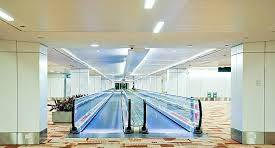
Air travel has become an increasingly stressful experience for many passengers, particularly at large and busy airports. Long queues, confusing layouts and the need to walk significant distances between gates can all contribute to heightened anxiety and frustration levels. This not only impacts the overall passenger experience but can also lead to operational bottlenecks and inefficiencies. One solution that has gained traction in recent years is the implementation of travelator systems, also known as moving walkways or flat escalators. These automated walkway systems can play a crucial role in reducing passenger stress while simultaneously improving operational flow within airport terminals.
Large airport terminals are complex environments that must accommodate a high volume of passengers, each with unique needs and schedules. Passengers often need to navigate long distances between check-in counters, security screening areas and departure gates, carrying luggage and navigating crowded spaces. Additionally, those with mobility issues or tight connection times face added challenges. These factors can contribute to increased stress levels, potentially leading to delays and operational inefficiencies.
Reduced Walking Distances
Travelator systems can significantly reduce the physical effort required by passengers to traverse long distances within airport terminals. By providing a moving walkway, passengers can conserve energy and reduce fatigue, leading to a more comfortable and stress-free travel experience. This benefit is particularly valuable for elderly or mobility-impaired individuals, as well as those with heavy luggage or families with young children.
Improved Passenger Flow
Travelators can facilitate the smooth flow of passengers through high-traffic areas, reducing congestion and bottlenecks. By providing a continuous stream of movement, these systems can help distribute passenger traffic more evenly, minimizing crowding and the associated stress and frustration.
Enhanced Accessibility
Travelators offer an accessible solution for passengers with mobility challenges, including those using wheelchairs, walkers, or crutches. By eliminating the need for strenuous walking or climbing stairs, these systems promote inclusivity and ensure a more equitable travel experience for all passengers.
Increased Operational Efficiency
By streamlining passenger movement and reducing congestion, travelator solutions can contribute to improved operational efficiency within airport terminals. Shorter queues, smoother security screening processes and more efficient boarding procedures can result in reduced delays and improved on-time performance, benefiting both passengers and airlines.
Strategic Placement
The strategic placement of travelator systems is crucial for maximizing their benefits. Careful analysis of passenger flow patterns, high-traffic areas and potential bottlenecks should inform the positioning of these systems within the terminal layout.
Integration with Existing Infrastructure
Travelator solutions must be seamlessly integrated with the existing airport infrastructure, ensuring compliance with safety regulations and accessibility standards. Careful planning and coordination are necessary to minimize disruptions during installation and maintenance.
Safety and Security Measures
The safety and security of passengers should be a top priority when implementing travelator systems. Appropriate safety measures, such as clear signage, emergency stop mechanisms and regular maintenance checks, must be in place to mitigate potential risks.
Energy Efficiency and Sustainability
Modern travelator systems are designed to be energy-efficient, contributing to the overall sustainability efforts of airports. Incorporating features like energy-saving modes and regenerative braking can further enhance the eco-friendly aspects of these solutions.
The implementation of travelator solutions within airport terminals offers numerous benefits, including reduced passenger stress, improved operational flow, enhanced accessibility and increased efficiency. By addressing the challenges associated with long walking distances and congestion, these automated walkway systems can significantly enhance the overall travel experience for passengers while simultaneously supporting the operational goals of airports. As air travel continues to grow, the adoption of travelator solutions will become increasingly important in maintaining high-quality service standards and meeting the evolving needs of modern air travel.
If you need any services, drop us a mail at Rohitkumar.Singh@gmrgroup.in or get in touch with us at +919717199753.